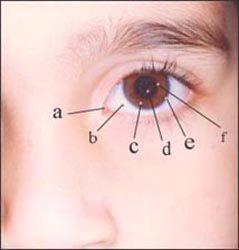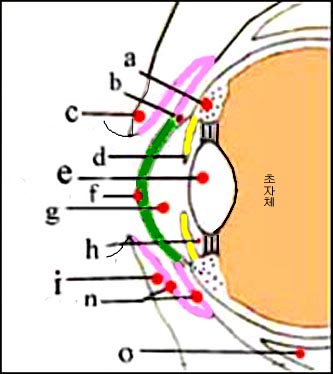각막 외상. Corneal trauma
각막 외상의 원인

사진 1-217. a-비루관 입구(코 눈물관 입구), b-공막, c-홍채, d-동공, e-연, f-각막
Copyright ⓒ 2011 John Sangwon Lee, MD., FAAP

그림 1-58. 초록색 부분이 각막이다
a-모양체(섬모체), b-쉴렘관, c-위 눈꺼풀, d-홍채, e-수정체(렌즈), f-각막, g-전방, h-후방, i-아래 눈꺼풀, n-결막, o-안구 근육(안구 하직근)
Copyright ⓒ 2011 John Sangwon Lee, MD., FAAP
- 각막 이물이라는 항에서 각막 외상에 관해 언급했다. 여기서는 각막 외상에 관해 더 설명한다.
- 티끌이나 작은 물체 등이 각막에 세게 튀어 들어갈 때 각막에 상처가 생길 수 있다.
- 또는 각막 표면이 손톱, 종이, 풀잎, 콘택트렌즈 등으로 긁히거나 찢어질 수 있고 살짝 벗겨질 수 있다.
- 살짝 긁힌 각막 층 표면 상처를 각막 찰과상이라고 한다.결막 이물 참조.
- 이와 같이 각막에 생긴 상처를 통틀어 각막 외상이라고 한다.
- 여러 종류의 각막 외상 중 각막 찰과상이 가장 흔하다.
각막 외상의 증상 징후
- 원인, 각막 외상의 정도, 합병증의 유무 등에 따라 증상 징후가 다르다.
- 각막 외상을 입은 눈은 몹시 아프다.
- 햇빛이나 밝은 전등 불빛이 그쪽 눈에 비치면 눈이 몹시 부셔서 뜰 수 없다.
- 눈물이 많이 나고 눈이 빨갛게 된다.
- 각막 외상의 정도에 따라 시력도 나빠질 수 있다.
- 어려서 말로 잘 표현할 수 없는 영유아들이 자신의 옷깃이나 손톱 등으로 자신의 각막에 외상을 입힐 수 있다.
- 그 눈이 갑자기 빨개지고, 눈을 잘 뜨지 못하며 마구 보챌 때는 각막 외상 등이 있는지 살펴보아야 한다.
각막 외상의 진단
- 병력, 증상 징후와 진찰소견 등을 종합해서 각막 외상을 진단할 수 있다.
- 각막 외상을 입었을 때 말로 표현할 수 있는 아이들은 무엇으로 눈을 다친 것 같다고 말할 때도 있다.
- 때로는 부모도 큰 각막 상처를 육안으로 볼 수 있다.
- 각막 외상을 입었다고 의심하면 그 쪽 눈에 안대를 대고 안과나 병원 응급실로 급히 데리고 가야 한다.
- 각막 외상을 입은 눈에 국소 마취 안 점적액제를 넣고 특수 안과 의료기계로 안구를 진찰해 각막 외상을 진단한다.
- 헐피스바이러스(헤르페스바이러스/Herpesvirus) 감염으로 헐피스바이러스 각막염이 생길 수 있다. 각막 외상의 증상 징후와 헐피스바이러스 각막염의 증상 징후가 비슷할 때도 있다. 그래서 이 두 병을 감별 진단해야 한다.
각막 외상의 치료
- 각막 외상을 입었다고 의심되면 병원 응급실이나 안과로 곧 데리고 가서 진단 치료를 받아야 한다.
- 눈이 아프면 국소 마취 안약 및, 또는 타이레놀 등으로 진통시킨다.
- 외상을 입은 각막에 항생제 안연고를 바르고 안대를 대고 각막 외상 생겨 있는 눈이 편히 쉬도록 하고 세균에 감염되지 않게 예방한다.
- 각막의 일부분이 째질 수 있다. 이런 각막 상처를 각막 열상이라 한다. 찢어진 심한 각막 열상은 병원 수술실에서 꿰매 주는 수술 치료를 받아야 한다.
Corneal trauma 각막 외상

Photo 1-217. a- nasolacrimal duct entrance (nasal tear duct entrance), b- sclera, c-iris, d-pupil, e-periphery, f-cornea. Copyright ⓒ 2011 John Sangwon Lee, MD., FAAP

Figure 1-58. The green part is the cornea. a-ciliary body, b-Schlem’s canal, upper eyelid, d-iris, e-lens. f-cornea, g-anterior, h-posterior, i-lower eyelid, n-conjunctiva, o-ocular muscle (inferior rectus eye) Copyright ⓒ 2011 John Sangwon Lee, MD., FAAP
Causes of corneal trauma
- Corneal trauma was mentioned in the section called corneal foreign body. Corneal trauma is further described here.
- When dust or small objects bounce hard into the cornea, the cornea can become scarred. Alternatively, the surface of the cornea may be scratched or torn with fingernails, paper, blades of grass, contact lenses, etc., and maybe slightly peeled off.
- A wound on the surface of the corneal layer that is slightly scratched is called a corneal abrasion. See Conjunctival Foreign Body. All of these wounds on the cornea are called corneal trauma. Of the many types of corneal trauma, corneal abrasions are the most common.
Symptoms, signs of corneal trauma
- Symptoms and signs differ depending on the cause, the degree of corneal trauma, and the presence or absence of complications.
- Eyes with corneal trauma are very painful.
- If sunlight or a bright light shines in his eyes, his eyes are so dazzling that he cannot open them.
- Tears come out a lot and his eyes become red.
- Depending on the degree of corneal trauma, vision can also worsen.
- Infants and toddlers who are young and cannot express well in words can inflict trauma to their cornea with their collars or fingernails.
- When the eyes suddenly turn red, the eyes are difficult to open, and when the eyes are swollen, you should look for corneal trauma.
Diagnosis of corneal trauma
- Corneal trauma can be diagnosed by synthesizing the medical history, symptoms, and examination findings.
- There are times when children who can describe verbal corneal trauma say that they seem to have injured their eyes with something.
- Sometimes parents can see large corneal wounds with the naked eye.
- If you suspect that you have suffered corneal trauma,
- You should put an eye patch on that eye and take it to an ophthalmologist or hospital emergency room in a hurry.
- Corneal trauma is diagnosed by putting a local anesthesia eye drop solution into an eye with corneal trauma and examining the eye with a special ophthalmic medical device.
- Herpesvirus infection can lead to herpesvirus keratitis.
- In some cases, the symptoms of corneal trauma are similar to those of herpes virus keratitis. So, these two diseases must be diagnosed differently.
Corneal trauma treatment
- If you suspect your child has a corneal trauma, you should take him to the hospital emergency room or ophthalmologist immediately for diagnosis and treatment.
- If your child’s eyes hurt, you can use local anesthetic eye drops or Tylenol to relieve pain. Antibiotic eye ointment is applied to the injured cornea, and an eye patch is put on it so that the corneal wounded eye can rest comfortably and prevent infection by bacteria.
- Part of the cornea may be lacerated.
- These corneal scars are called corneal lacerations.
- Severe torn corneal lacerations require surgical treatment with stitching in a hospital operating room.
출처 및 참조 문헌 Sources and references
- NelsonTextbook of Pediatrics 22ND Ed
- The Harriet Lane Handbook 22ND Ed
- Growth and development of the children
- Red Book 32nd Ed 2021-2024
- Neonatal Resuscitation, American Academy Pediatrics
- 결막 이물-www.drleepediatrics.com 제19권. 소아청소년 안(눈)과 질환
- 눈의 이물-www.drleepediatrics.com 제19권. 소아청소년 안(눈)과 질환
- 각막 이물-www.drleepediatrics.com 제19권. 소아청소년 안(눈)과 질환
- 안구 속에 들어간 이물 참조-www.drleepediatrics.com 제19권. 소아청소년 안(눈)과 질환
- Emergency Medical Service for Children, By Ross Lab. May 1989. p.10
- Emergency care, Harvey grant, and Robert Murray
- Emergency Care Transportation of Sick and Injured American Academy of Orthopaedic Surgeons
- Emergency Pediatrics A Guide to Ambulatory Care, Roger M. Barkin, Peter Rosen
- Quick Reference To Pediatric Emergencies, Delmer J. Pascoe, M.D., Moses Grossman, M.D. with 26 contributors
- Manual of Emergency Care 응급환자관리 정담미디어
- 소아가정간호백과-부모도 반의사가 되어야 한다, 이상원 저
- The pregnancy Bible. By Joan stone, MD. Keith Eddleman, MD
- Preparation for Birth. Beverly Savage and Dianna Smith
- 임신에서 신생아 돌보기까지. 이상원
- Breastfeeding. by Ruth Lawrence and Robert Lawrence
- Nelson Textbook of Pediatrics 14th ed. Beherman,
- The Johns Hopkins Hospital, The Harriet Lane Handbook, 18th edition
- Red book 29th-31 st edition 2021
- Nelson Text Book of Pediatrics 19th-21st Edition
- Infectious disease of children, Saul Krugman, Samuel L Katz, Ann A. Gershon, Catherine Wilfert
- The Harriet Lane Handbook 19th EditionGrowth and Development of Children, George H. Lowrey 8th edition
- 소아과학 대한교과서
- 제1권 소아청소년 응급의료 참조문헌과 출처
- Other
Copyright ⓒ 2015 John Sangwon Lee, MD., FAAP
“부모도 반의사가 되어야 한다”-내용은 여러분들의 의사로부터 얻은 정보와 진료를 대신할 수 없습니다.
“The information contained in this publication should not be used as a substitute for the medical care and advice of your doctor. There may be variations in treatment that your doctor may recommend based on individual facts and circumstances. “Parental education is the best medicine.”